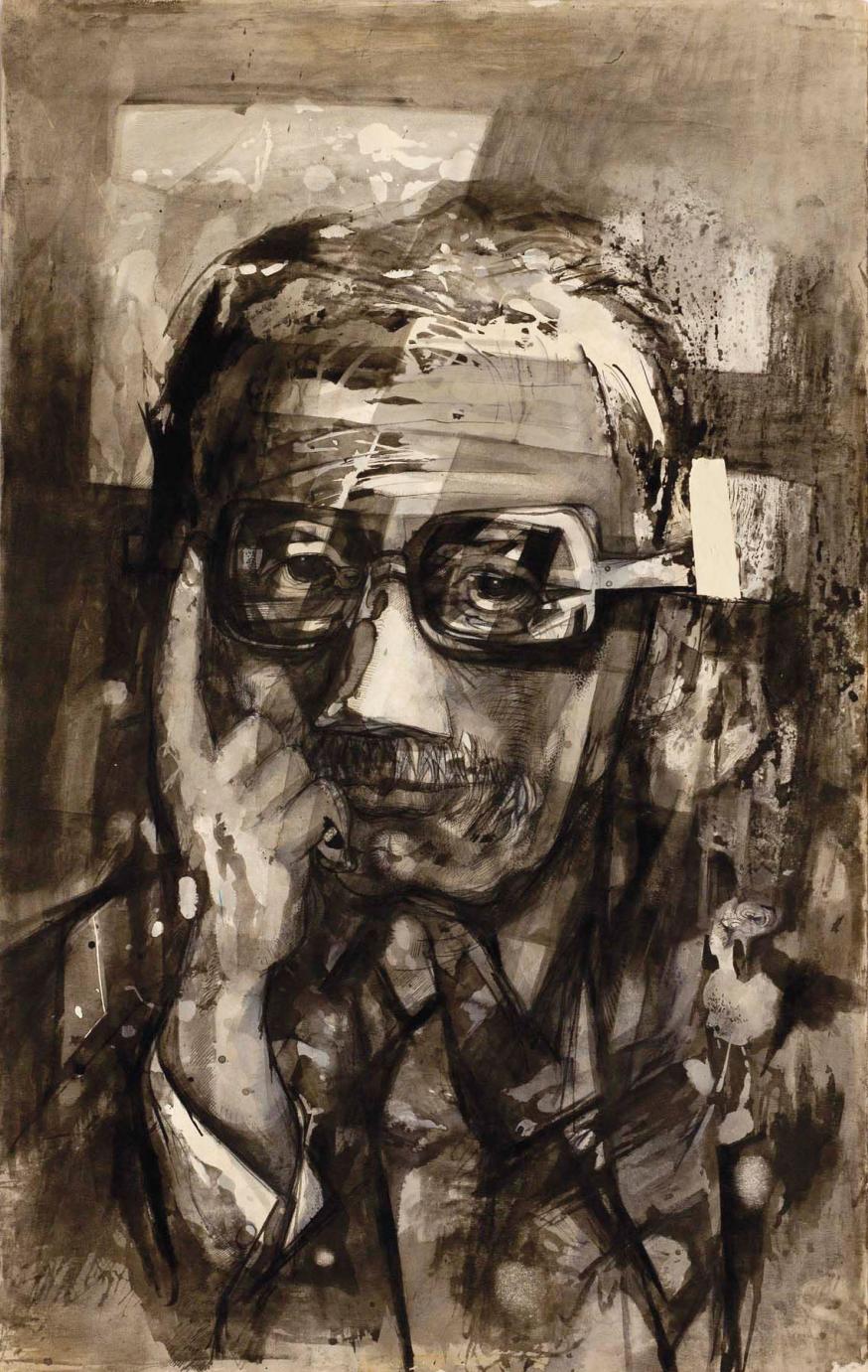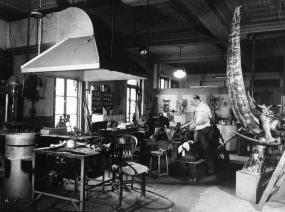Theodore Roszak
1907–1981


Theodore Roszak in his Greenwich Village home and studio at 1 St. Luke’s Place, c.1960; Photographer unknown, © Estate of Theodore Roszak
All artworks displayed above are currently available. To inquire about additional works available by this artist, please contact the gallery.
Biography
The forms that I find necessary to assert, are meant to be blunt reminders of primordial strife and struggle, reminiscent of those brute forces that not only produced life, but in turn threatened to destroy it. I feel that if necessary, one must be ready to summon one’s total being with an all-consuming rage against those forces that are blind to the primacy of life-giving values. Perhaps by this sheer dedication, one may yet merge force and grace.
Born in Posen (now Poznan), Poland, Theodore Roszak (1907–1981) was two years old when his family moved to Chicago, settling among the city’s large Polish community. Roszak’s mother was a dress designer who nurtured his interest in art and, in 1920, he won the Chicago Herald-Examiner’s National Art Contest for Public Schools. He pursued serious art study as a teenager, taking classes at the School of the Art Institute of Chicago, and after finishing high school in 1924, Roszak enrolled at the Art Institute full time. After winning two of the Institute’s awards in his first year, Roszak decided to move to New York to study privately with Ashcan School painter George Luks and take philosophy courses at Columbia University. In 1929 Roszak was awarded a fellowship that allowed him to spend two years in Europe, where he first discovered the work of Metaphysical painter Giorgio de Chirico, whose desolate, enigmatic scenes of Classical architectures would have a formative impact on the young artist. While living in Prague, Roszak also befriended a circle of artists who introduced him to the principles of Bauhaus design and Constructivist ideology, two schools of thought that the young artist would take up as his own guiding principles in his early career.
Roszak returned to the United States in 1930 to live and work at the Tiffany Foundation on Long Island. The decade that followed would be defined by a series of early successes; in 1931, he established a small studio on Staten Island, where he began experimenting with machine-shop tools and composing plaster models of his earliest constructions. By 1933, the Whitney Museum of American included his work in the First Biennial of Contemporary American Painting and the Art Institute of Chicago awarded him the Eisendrath Award for Painting. The following year, Roszak moved his studio to 241 East 33rd Street in Manhattan, where he was able to devote more time to his sculpture practice. Like many American artists during the Great Depression, he was able to find regular work through the Federal Art Project: he taught at the Design Laboratory, a tuition-free, experimental design school that promoted Bauhaus and Constructivist approaches to art and opened under the aegis of the Works Progress Administration. The year 1935 proved to be even more prodigious, as the Whitney selected his painting Fisherman’s Bride (1934) for their second Biennial and then purchased the work for their permanent collection. Another of his paintings, Seated Figure (1930), was awarded The Joseph N. Eisendrath Prize by the Art Institute of Chicago, and the Roerich Museum’s International Art Center in New York staged the artist’s first solo exhibition.
The second half of the 1930s witnessed the creation of Roszak’s first mature “constructions”: sleek, free-standing and wall-mounted sculptures of plastic and wood rooted in pure geometric abstraction. After the Design Laboratory closed, Roszak found work assisting industrial designer Norman Bel Geddes at the 1939 World’s Fair in Flushing Meadows, New York, where they constructed a large-scale model of futuristic urban centers and connecting highways. From 1940 to 1945, Roszak designed and fabricated aircraft as an employee at the Brewster Aircraft Corporation in Newark, NJ, including an experimental bomber. This undertaking left an indelible mark on his art, as the destruction wrought by the machinery of war left the artist deeply critical of the constructivist ideology’s optimistic faith in technology. He began welding with an oxyacetylene torch, and his compositions evolved away from the streamlined style he had previously embraced. Although Roszak’s welded sculptures continued to be abstract, their forms took on a far more expressionistic quality, manifesting an organic, surrealistic style that stands in sharp contrast to the architectural, man-made forms of his early career. This shift was presaged in a series of gouaches created in the early 1940s that explored questions of myth and ritual, an interest he shared with mythologist Joseph Campbell, a colleague of Roszak’s at Sarah Lawrence College, where the artist taught from 1941 to 1955. In 1948, the Museum of Modern Art bought its first Roszak sculpture, Spectre of Kitty Hawk (1946–47).
Roszak’s career continued to thrive throughout the 1950s and 1960s. In 1956, the Rodin Museum in Paris mounted a solo exhibition of his work, and a traveling mid-career retrospective was organized by the Walker Art Center in Minneapolis. In 1959, he received a grant from the Ford Foundation, New York, and was included in the landmark New Images of Man exhibition at MoMA. As his career grew, so did the scale of his work and his interest in flight. In the late 1950s, Roszak created an aluminum eagle weighing a full ton with a wingspan of over thirty-five feet for Eero Saarinen’s US Embassy building in London. For the 1964 World’s Fair, Roszak welded his colossal Forms in Transit—a rocket-shaped, forty-three-foot sculpture comprised of aluminum, steel, and sheet metal—and in 1968, his twenty-five-foot bronze Sentinel was installed at the Public Health Laboratories on East 27th Street, New York. In 1969, Roszak began a six-year position as a member of the Fine Arts Commission, and in 1971, he was elected to the Board of Trustees of the American Academy in Rome. That year the artist suffered a heart attack and his physical health began a slow decline, causing an attenuation of his sculptural production. Refocusing his remaining energies on his drawing practice, Roszak cultivated an expansive body of late works on paper characterized by fantastical subjects, satire, politics, and science fiction before succumbing to heart failure in 1981.
Michael Rosenfeld Gallery first began exhibiting Roszak’s work in 1992. Upon taking on representation of the estate in 2008, the gallery mounted Theodore Roszak from September 6–October 25 of that year. In 2016, Theodore Roszak: Propulsive Transfiguration, A Survey of Drawings from 1928–1980 (March 25–May 14) opened with a public conversation between Sara Roszak, the artist’s daughter, and art historian Robert Slifkin. In 2021, the Minneapolis Institute of Art received a gift of nearly 800 of Roszak’s drawings and prints from the estate, rendering Mia the leading institution for the artist’s works on paper.
Works by Theodore Roszak are in numerous public collections including the Addison Gallery of American Art, Phillips Academy, Andover, MA, Akron Art Museum, Akron, OH, Albany Museum of Art, Albany, GA, Arizona State University Art Museum, Tempe, AZ, Arkansas Arts Center, Little Rock, AR, The Art Institute of Chicago, Chicago, IL, The Baltimore Museum of Art, Baltimore, MD, Ball State University Museum of Art, Muncie, IN, The British Museum, London, England, Cantor Center for Visual Arts, Stanford University, Stanford, CA, Cape Ann Museum, Gloucester, MA, Carnegie Museum of Art, Pittsburgh, PA, Chazen Museum of Art, University of Wisconsin, Madison, WI, Cincinnati Art Museum, Cincinnati, OH, The Cleveland Museum of Art, Cleveland, OH, Colorado University Art Museum, Boulder, CO, Columbus Museum, Columbus, GA, Crystal Bridges Museum of Art, Bentonville, AR, Currier Museum of Art, Manchester, NH, Faulconer Gallery, Grinnell College, Grinnell, IA, Fine Arts Museums of San Francisco, San Francisco, CA, Fisher Gallery, University of Southern California, Los Angeles, CA, The Flint Institute of the Arts, Flint, MI, Grinnell College Art Collection, Grinnell, IA, Harvard University Art Museums, Cambridge, MA, The Heckscher Museum, Huntington, NY, The High Museum of Art, Atlanta, GA, Hirshhorn Museum and Sculpture Garden, Smithsonian Institution, Washington, DC, Indianapolis Museum of Art, Indianapolis, IN, Joslyn Art Museum, Omaha, NE, Krannert Art Museum, University of Illinois, Urbana, IL, Kresge Art Museum, Michigan State University, East Lansing, MI, List Visual Arts Center, Massachusetts Institute of Technology, Cambridge, MA, Los Angeles County Museum of Art, Los Angeles, CA, The Metropolitan Museum of Art, New York, NY, Minneapolis Institute of Art, Minneapolis, MN, Minnesota Museum of Art, St. Paul, MN, Montclair Art Museum, Montclair, NJ, The Morgan Library and Museum, New York, NY, Museu de Arte Moderna, Sao Paulo, Brazil, Museum of Art, Fort Lauderdale, FL, Museum of Art, University of Michigan, Ann Arbor, MI, Museum of Fine Art, Houston, TX, Museum of Fine Arts, Boston, MA, Museum of Modern Art, New York, NY, National Gallery, Washington, DC, Nelson-Atkins Museum of Art, Kansas City, MO, The New Jersey State Museum, Trenton, NJ, New Museum of Contemporary Art, New York, NY, Neuberger Museum, State University of New York, Purchase, NY, The Newark Museum, Newark, NJ, Norton Museum of Art, West Palm Beach, FL, Palmer Museum of Art, Pennsylvania State University, University Park, PA, Pennsylvania Academy of the Fine Arts, Philadelphia, PA, Philadelphia Museum of Art, Philadelphia, PA, Phoenix Art Museum, Phoenix, AZ, San Francisco Museum of Art, San Francisco, CA, St. Louis Art Museum, St. Louis, MO, Sheldon Memorial Art Gallery, University of Nebraska, Lincoln, NB, The David and Alfred Smart Museum. The University of Chicago, Chicago, IL, Smithsonian American Art Museum, Washington, DC, Solomon R. Guggenheim Museum, New York, NY, Storm King Art Center, Mountainville, NY, Tate Modern, London, England, Ulrich Museum of Art, Wichita State University, Wichita, KS,
University of Iowa Museum of Art, Iowa City, IA, Wadsworth Atheneum Museum of Art, Hartford, CT, Walker Art Center, Minneapolis, MN, Weatherspoon Art Museum, University of North Carolina, Greensboro, NC, Whitney Museum of American Art, New York, NY, Williams College Museum of Art, Williamstown, MA, Worcester Museum of Art, Worcester, MA, and Yale University Art Gallery, New Haven, CT.
Michael Rosenfeld Gallery LLC has represented the Estate of Theodore Roszak in cooperation with Jeffrey Hoffeld Fine Art since 2008.
Gallery Exhibitions
Press

